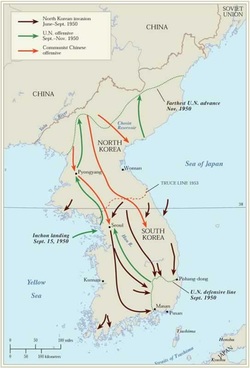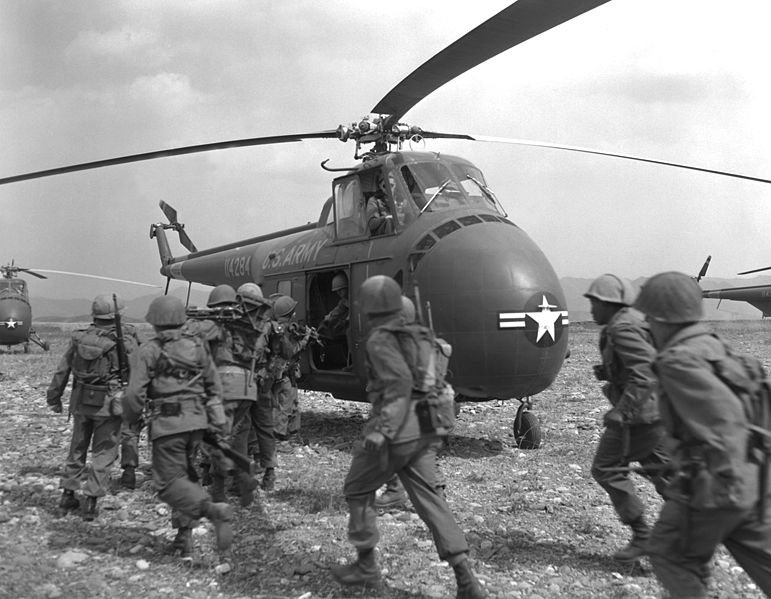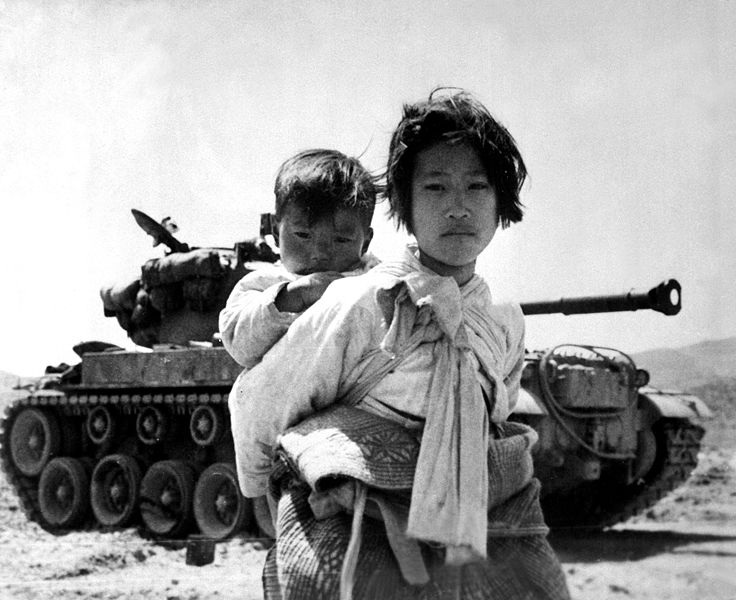Timeline for Korean War
16 84,478 U.S. troops participate in the defense of the Pusan Perimeter, including the U.S. Army's 1st Cavalry Division, 2nd, 24th, and 25th Infantry Divisions, and the 1st Provisional Marine Brigade.
Sept. 15
Inchon Landing (Operation CHROMITE). U.S. and allied forces land U.S. Marines and U.S. Army troops at Inchon.
Sept. 15-30
Inchon Operation and Liberation of Seoul. U.S. and allies re-capture Seoul on Sept. 27 after a week of fighting.
Sept. 16-27
Pusan Perimeter breakout. Eighth U.S. Army (EUSA) breaks out of the Pusan Perimeter. Four U.S. divisions (1st Cavalry Division, 2nd, 24th and 25th Infantry Divisions) participate.
Oct 20
War's first airborne operation. Seventy-one C-119s and 40 C-47s of the Far East Air Force's (FEAF) Combat Cargo Command drop 2,860 paratroopers of the 187th Airborne Regimental Combat Team (RCT) at Sukch'on and Sunch'on north of Pyongyang. Only one trooper killed and 36 injured in jump. Paratroopers, in association with ground forces driving north, kill or capture about 6,000 North Koreans during this operation.
Oct. 25
Chinese Communist Forces (CCF) launch their first phase offensive of the Korean War.
Nov. 8
First all-jet combat in history. An F-80 Shooting Star of the 51st Fighter Interceptor Wing shoots down a MiG-15 fighter near Sinuiju in a 30-second dogfight.
Nov. 8-26
FEAF B-29s and Navy aircraft attack Yalu River bridges in attempt to isolate the battlefield.
Nov. 25 -
Dec. 15
CCF Counteroffensive in North Korea. Seven U.S. divisions participate (1st Marine Division, U.S. Army's 1st Cavalry Division, 2nd, 3rd, 7th, 24th and 25th Infantry Divisions).
Nov. 27 -
Dec. 9
Battle of the Changjin (Chosin) Reservoir. The encircled 1st Marine Division fights its way southward from the Chosin Reservoir to the port city of Hungnam.
Dec. 24
Hungnam Operation is complete—the U.S. Navy evacuates 105,000 U.S. and Republic of Korea (ROK) forces.
Sept. 15
Inchon Landing (Operation CHROMITE). U.S. and allied forces land U.S. Marines and U.S. Army troops at Inchon.
Sept. 15-30
Inchon Operation and Liberation of Seoul. U.S. and allies re-capture Seoul on Sept. 27 after a week of fighting.
Sept. 16-27
Pusan Perimeter breakout. Eighth U.S. Army (EUSA) breaks out of the Pusan Perimeter. Four U.S. divisions (1st Cavalry Division, 2nd, 24th and 25th Infantry Divisions) participate.
Oct 20
War's first airborne operation. Seventy-one C-119s and 40 C-47s of the Far East Air Force's (FEAF) Combat Cargo Command drop 2,860 paratroopers of the 187th Airborne Regimental Combat Team (RCT) at Sukch'on and Sunch'on north of Pyongyang. Only one trooper killed and 36 injured in jump. Paratroopers, in association with ground forces driving north, kill or capture about 6,000 North Koreans during this operation.
Oct. 25
Chinese Communist Forces (CCF) launch their first phase offensive of the Korean War.
Nov. 8
First all-jet combat in history. An F-80 Shooting Star of the 51st Fighter Interceptor Wing shoots down a MiG-15 fighter near Sinuiju in a 30-second dogfight.
Nov. 8-26
FEAF B-29s and Navy aircraft attack Yalu River bridges in attempt to isolate the battlefield.
Nov. 25 -
Dec. 15
CCF Counteroffensive in North Korea. Seven U.S. divisions participate (1st Marine Division, U.S. Army's 1st Cavalry Division, 2nd, 3rd, 7th, 24th and 25th Infantry Divisions).
Nov. 27 -
Dec. 9
Battle of the Changjin (Chosin) Reservoir. The encircled 1st Marine Division fights its way southward from the Chosin Reservoir to the port city of Hungnam.
Dec. 24
Hungnam Operation is complete—the U.S. Navy evacuates 105,000 U.S. and Republic of Korea (ROK) forces.

Map on Korean War & countries involved.
Most Important people
Mao ZeDong; chairman of Communist China, brutal dictator
-Joseph Stalin; leader of Soviet Russia/USSR, communist, leader of Superpower
-Kim Il Sung; leader of N. Korea, wanted to united Korea under Communism
-Joseph Stalin; leader of Soviet Russia/USSR, communist, leader of Superpower
-Kim Il Sung; leader of N. Korea, wanted to united Korea under Communism
Link on Wilson's Idea
http://www.dummies.com/how-to/content/woodrow-wilsons-fourteen-points.html


